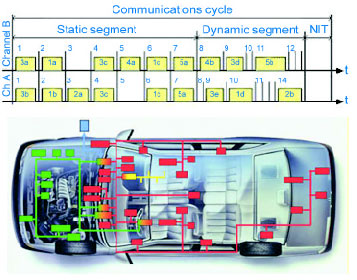| 2006 |

|
YEAR BOOK |
Waterford Institute of Technology
|
A paradigm shift in automotive networks
|

CAN (Controller Area Network) is an event-driven network which is a commonly used standard in the industry. CAN operates on a similar basis to Ethernet in the computer networking industry, using a CSMA type of protocol to determine message access to the network. Event-driven networks react to events as they occur. In order to prevent collisions on the CAN network, messages are given unique identifying numbers which determine priorities for network access. For example, a message destined for the airbag in the event of an accident would have a higher priority than a message destined for the volume control on the stereo. One of the major difficulties of such a system is that the occurrence of events is obviously random and therefore it is impossible to exhaustively test an event-driven network for every possible combination of event occurrence.
With the development of new applications and systems such as 'x-by-wire' where normal mechanical systems such as steering are controlled by software as opposed to a mechanical link, comes the need for higher speed networks that are fault-tolerant, deterministic and can be exhaustively tested to ensure safety. These demands have led to the development of Time-triggered networks such as TTCAN (Time-Triggered Controller Area Network) and FlexRay. Time-triggered networks work on the principle of a cyclical schedule, which determines message access to the network. This approach means that the system can be exhaustively tested for 'action � reaction' deadlines, as the schedule of messages is predetermined. A predetermined schedule also allows for more efficient use of the available network bandwidth.
The Automotive Control Group at Waterford Institute of Technology carries out research to postgraduate level in automotive networking, diagnostics, telematics and control systems. The group has successfully completed research on the performance analysis of time-triggered networks for an international automotive systems supplier. The results of this research will be used to optimise the design of future x-by-wire automotive applications. The group has recently received funding from an industrial partner to investigate the use of FlexRay networking for specific automotive applications. Additional funding has also been received from Enterprise Ireland for the application of advanced software engineering techniques to automotive software using the up-coming AUTOSAR standard.
Contact: Brendan Jackman or David Power,
Automotive Control Group,
Waterford Institute of Technology.
Tel. 051-302435
E-mail: [email protected] Web: www.wit.ie/automotive